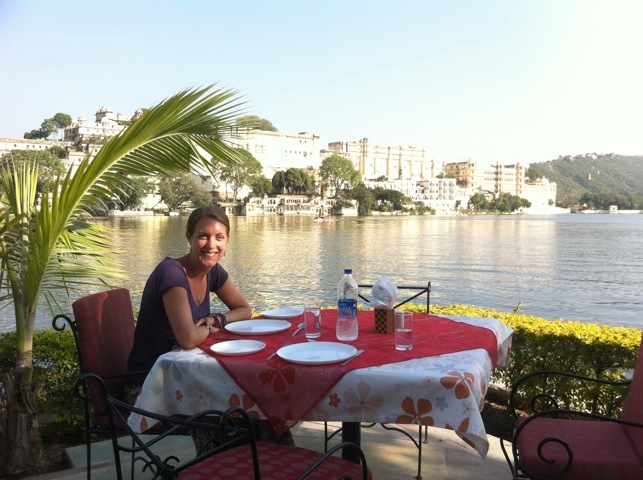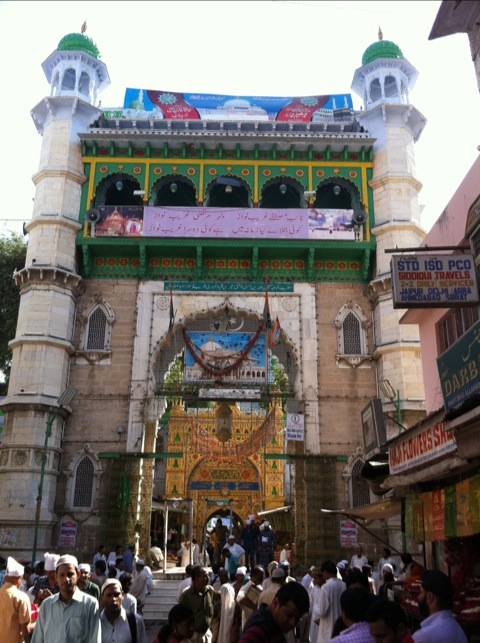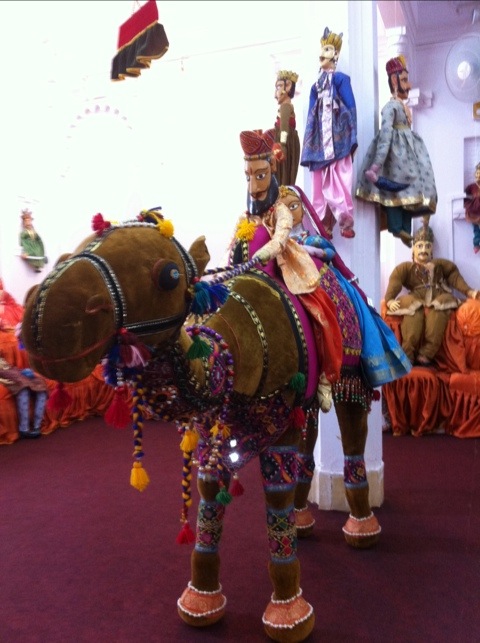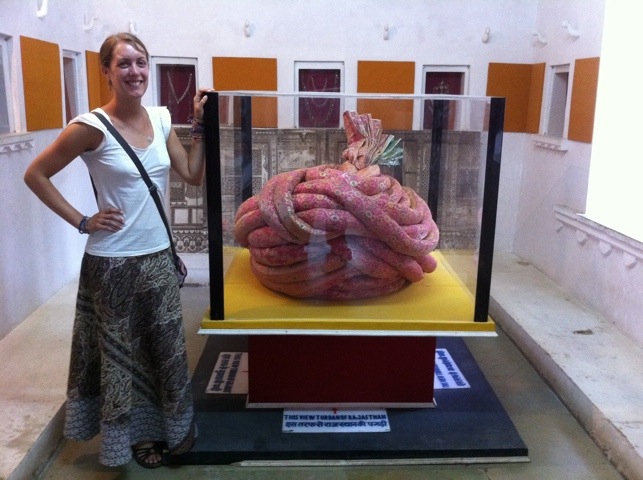With Laura’s love of spice and mine of curry, it had to happen really. We’re hooked on the food! Our shaky stint of food poisoning well behind us, we’ve been savouring the delights of fine dining Indian style (in flavour if not necessarily the surroundings), and are loving it!
On the way out of Pushakr, we stopped in Ajmer for a flavour of some Muslim sightseeing, and then a cheap but classy lunch before our journey on to Udaipur. The mausoleum we visited in Ajmer was impressive, but sadly somewhat impenetrable to us as foreigners, and non-Muslims at that. We nearly failed at the first hurdle – finding the cloakroom, which was hidden away in another building cunning disguised as a guest house in a busy alleyway a few streets away. The mausoleum complex was in gleaming marble, with huge metal people-sized pots for the faithful to make their donations, and a community atmosphere within, with lots of people sitting around chatting amid vendors and worshippers, water pools and a mosque. We were even invited by a family to join them for a cup of chai before we left, but were sadly short on time and had to let it pass.
Udaipur is known as the White City, but is more memorable for its duo of beautiful lakes, with two shimmering white palaces apparently floating in the water. It’s certainly the most picturesque city we’ve visited so far – so cinematic is the view that this was used as the location for the James Bond film Octopussy, where the villain was holed up in one of the beautiful palaces on islands in the lake. Predictably, most tourist restaurants try to drum up trade through a nightly showing of the film – although we didn’t quite manage to fit this into our schedule.

Sightseeing-wise, we got our fill of the city palace, with decorative peacocks and mirrored rooms with commanding views over the streets below as well a rabble of shouting and gawping schoolkids. We also went on a sunset lake tour by boat, which was beautiful if slightly cloudy – the whole place really looks stunning over the water.

One of the highlights of the city itself was a fantastically restored old Haveli, essentially a mansion set around a courtyard. The first floor found us in a bizarre but impressive room of marionette puppets, with the puppetmaker on hand to demonstrate them. As well as a huge array of conventional puppets – sitting on camels, on cushions, sized as miniatures and life-size – there were also some that could do special effects! One that could shake its hips while dancing; another that could hold its head in its hands or feet; and most surprising of all, a female dancer with a long skirt who could do a handstand, only to become a male puppet (with skirt) when turned upside down! Certainly a unique skill, if slightly unexpected!
The Haveli had been lovingly restored after falling into ruin, and was a colourful insight into life as it was for the rich upper classes, with a kaleidoscope of stained glass illuminating rooms of embroidered fabrics and painted motifs, and punkahs hanging from the ceiling – strips of fabric that would be wafted by a servant pulling a cord around the clock to serve as a fan. There were also two slightly more quirky exhibits: what purported to be the largest turban in the world (although with no statistics to support this), an impressive coil of cloth that looked like it might only fit a giant; and a collection of hand-sculpted monuments from around the globe. In polystyrene. And so we hereby present the world’s largest turbans, and a truly 21st century Taj Mahal for your visual pleasure.
We also briefly took on our celebrity personas when we visited the second of Udaipur’s lakes. After a quick visit to the Moti Mahal, a set of gardens and ruins that we still don’t understand anything at all about (except that the swings are great!), we took a quick boat ride out to a small island with a cafe. The island was temporarily home to lots of Delhi kids on a school trip to Rajasthan, and we had a paparazziesque journey back across the water with them all crowding round us for photos, handshakes and inquisition. We even got a round of applause at one moment when they declared us to be ‘a lovely couple’! (Note: for the benefit of those new to our adventures, we may be lovely but we’re not a couple!)

Our culinary endeavours started with a fun lunch of sweet curries at a place we nicknamed Queenie’s. About as homely as a cafe could be, we sat at the dining table in the main room of their small house and they produced a sumptuous selection of fruit-based dishes, while the kids all crowded round my iPhone playing the universal game ‘Cut The Rope’ with delight. Buoyed by exotic flavours and full stomachs, we then joined a cookery class for the evening with Shashi, an amazing woman with incredible enthusiasm and a heartbreaking story.
Widowed ten years ago, she had to observe the customs expected of a bereaving Brahmin wife – spending 45 days siting in silence in the corner of her home, fasting during daylight hours while female family members wept before her. With this over, she began the rest of her life – forbidden from working due to her caste, and seen by all as an omen of bad luck as a widow. With two young sons, she was just able to scrape by, working secretly as a washer-woman, receiving one rupee (just over a penny) for each item of clothing she scrubbed – while the guest-houses she was working for would be charging five or ten rupees to their customers. Her break came three years ago when one of her sons brought home some tourist friends, who suggested she start teaching people to cook. As someone who didn’t speak any English, this was hugely daunting, but she persevered – and helped by the voluntary efforts of visiting translators, photographers, website designers and typists, she has now established herself as a hugely successful entrepreneur, with others now trying to imitate her – including, in a wonderful piece of karma, the very guesthouse owners who had paid her just one rupee for washing clothes.
The course we did with Shashi was amazing – and at four hours long for 550 rupees (£7) was fantastic value, especially when it overran to 5 1/2 hours because of so much interesting chatter, and we got a very tasty dinner too! It was heartwarming to see the contributions other travellers had made over the years – from the gifts in kind previously mentioned, to a chef’s knife brought out with friends who visited later, and most impressive of all, an entire hardback cookery book of her recipes made by a professional photographer who had visited – the first she knew about it was when the completed book appeared in the post! All in all, as much as the flavours were wonderful and we look forward to experimenting with the recipes on those back home, it was really hearing Shashi’s life story in the context of her home that seemed to give us a true taste of India – and a sweet one at that.
Simon





